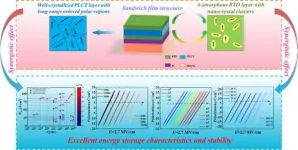(Press-News.org) Your ability to remember and recall moments in time is important for recording life-defining moments and everyday information like where you parked the car. Now researchers reporting in the journal Cell on March 29 have new insight into how those episodic memories are encoded in the brain based on studies of how chickadees store food.
Their study finds that chickadees activate unique neural patterns, which they liken to barcodes, each time they cache food in a certain spot. When they go back to retrieve that stored food, their brains light back up with that precise pattern.
“We find that each memory is tagged with a unique pattern of activity in the hippocampus, the part of the brain that stores memories,” said Dmitriy Aronov of Columbia University’s Zuckerman Institute. “We called these patterns ‘barcodes’ because they are extremely specific labels of individual memories—for example, barcodes of two different caches are uncorrelated even if those two caches are right next to each other.”
Scientists have known for decades that the hippocampus of the brain is required for episodic memory, but it had been much harder to understand exactly how those memories were encoded. That’s in part because it’s hard to know in most cases what an animal might be remembering at a particular time.
To get around this problem in the new study, Aronov and colleagues looked to chickadees. They realized chickadees offered a unique opportunity to study episodic memories because the birds cache food items and then must remember to go back for them later.
“Each cache is a well-defined, overt, and easily observable moment in time during which a new memory is formed,” Aronov says. “By focusing on these special moments in time, we were able to identify patterns of memory-related activity that had not been noticed before.”
It still wasn’t easy to do. The researchers had to engineer arenas that allow detailed and automated tracking of behavior as chickadees cache and retrieve food. They also had to develop technologies for large-scale, dense neural recordings in their brains as the birds moved about freely.
Their brain recordings during caching revealed very sparse, transient barcode-like patterns of firing across hippocampal neurons. Each barcode involves only about 7% of the cells in the hippocampus.
“When a bird makes a cache, about 7% of the neurons respond to that cache,” Aronov says. “When a bird makes a different cache, a different group of 7% of neurons respond.”
Those neural barcodes happened together with conventional activity of neurons in the brain that are triggered in response to particular places, appropriately called place cells. But, interestingly, the episodic memory barcodes for caching locations that were close to each other had no resemblance.
“It was widely assumed that when an animal forms a new memory, place cells change,” Aronov said. “For example, place cells might increase or decrease their firing near the location of a cache. Although this was the prevailing hypothesis, our data did not support it. It seems that place cells do not represent information about caches and rather remain relatively stable as a chickadee caches and retrieves food in the environment. Instead, episodic memories are represented by an additional pattern of activity—the ‘barcode’—which coexists with place cells.”
The researchers liken the newly discovered hippocampal barcodes to computer hash codes, which are patterns assigned as unique identifiers to different events. They suggest that the barcode-like patterns could be a mechanism for rapid formation and storage of many non-interfering memories.
Aronov says that perhaps the biggest outstanding question is whether and how barcodes are used by the brain to drive behavior. It’s not clear whether chickadees activate the barcodes and use those memories of food-caching events as they make decisions about where to go next, for example. The researchers say these are questions they plan to address in future studies through more complex environments in the lab in which they’ll record brain activity while the birds make choices about which food caches to visit.
###
This work was supported by the Beckman Foundation, the New York Stem Cell Foundation, the Simons Society of Fellows, and the NIH.
Cell, Chettih et al. “Barcoding of episodic memories in the hippocampus of a food-caching bird” https://cell.com/cell/fulltext/S0092-8674(24)00235-6
Cell (@CellCellPress), the flagship journal of Cell Press, is a bimonthly journal that publishes findings of unusual significance in any area of experimental biology, including but not limited to cell biology, molecular biology, neuroscience, immunology, virology and microbiology, cancer, human genetics, systems biology, signaling, and disease mechanisms and therapeutics. Visit http://www.cell.com/cell. To receive Cell Press media alerts, contact press@cell.com.
END
NEW YORK, NY — Black-capped chickadees have extraordinary memories that can recall the locations of thousands of morsels of food to help them survive the winter. Now scientists at Columbia's Zuckerman Institute have discovered how the chickadees can remember so many details: they memorize each food location using brain cell activity akin to a barcode. These new findings may shed light on how the brain creates memories for the events that make up our lives.
"We see the world through our memories of objects, places and people," said Dmitriy Aronov, PhD, a principal investigator at Columbia’s Zuckerman Institute and an ...
Researchers Yuta Sunakawa, Ko Mochizuki, and Atsushi Kawakita of the University of Tokyo discovered the first orchid species pollinated by gall midges, a tiny fly species. This is the first documented case of an orchid species found to be pollinated by gall midges, and it makes the orchids the eleventh such plant family. The findings were published in the journal Ecology.
The family of orchids is rich both in numbers and variety. Their range of shapes and sizes is due to having evolved to attract different animal pollinators. However, scientists have only mapped ...
In the ongoing fight against cancer, scientists around the globe are exploring innovative approaches to unlock the mysteries of the human immune system — the complex network of organs, cells and proteins that defends the body against disease.
A team led by Arizona State University scientists have developed an AI-based learning tool called HLA Inception that’s uncovered new information about how an individual person’s immune system responds to foreign cells.
Focusing on a group of proteins called Major Histocompatibility Complex-1(MHC-1), the AI-based tool, in seconds, can classify the specific group of proteins unique for ...
About The Study: This study found that the more states were inclined to vote Republican, the more likely their vaccine recipients or their clinicians reported COVID-19 vaccine adverse events. These results suggest that either the perception of vaccine adverse events or the motivation to report them was associated with political inclination.
Authors: David A. Asch, M.D., M.B.A., of the University of Pennsylvania in Philadelphia, is the corresponding author.
To access the embargoed study: Visit our For The Media website at this link https://media.jamanetwork.com/
(doi:10.1001/jamanetworkopen.2024.4177)
Editor’s ...
About The Study: The findings of this study suggest that biosimilar competition was not consistently associated with lower out-of-pocket costs for commercially insured outpatients, highlighting the need for targeted policy interventions to ensure that the savings generated from biosimilar competition translate into increased affordability for patients who need biologics.
Authors: Benjamin N. Rome, M.D., M.P.H., of Brigham and Women’s Hospital in Boston, is the corresponding author.
To access the embargoed study: ...
MRI of the prostate, combined with a blood test, can help determine if a prostate lesion is clinically significant cancer, new research suggests
A new meta-analysis by investigators from Brigham and Women’s Hospital, a founding member of the Mass General Brigham healthcare system, suggests that doctors and patients can avoid unnecessary prostate biopsies by combining MRI of the prostate findings with prostate-specific antigen (PSA) density. This new approach to diagnosing clinically significant prostate cancer can decrease patient ...
PHILADELPHIA – When cells in the human body divide, they must first make accurate copies of their DNA. The DNA replication exercise is one of the most important processes in all living organisms and is fraught with risks of mutation, which can lead to cell death or cancer. Now, in a landmark finding, biologists from the Perelman School of Medicine at the University of Pennsylvania and from the University of Leeds have identified a multi-protein “machine” in cells that helps govern the pausing or stopping of DNA replication to ensure its smooth progress.
The discovery, published today in Cell, advances the understanding of DNA replication, helps explain ...
The lipids in some herbal teas have been identified in detail for the first time, preparing the ground for investigating their contribution to the health benefits of the teas.
Herbal teas are enjoyed worldwide, not only for their taste and refreshment but also for a wide range of reputed health benefits. But the potential significance of a category of compounds called lipids in the teas has been relatively unexplored. Researchers at Hokkaido University, led by Associate Professor Siddabasave Gowda and Professor Shu-Ping Hui of the Faculty of Health Sciences, have now identified 341 different molecular species from five categories of lipids in samples of four types of herbal ...
As a green, sustainable, and competitive technology relative to batteries and electrochemical capacitors and featuring a high charge storage capability, the dielectric capacitors excel in low cost, long cycle-life, and a broad operating temperature range, as well as environmental friendliness, high security, and good reliability. Most importantly, they top other technologies in terms of ultra-high-power density due to their unrivaled charge-discharge speed. These features have created a number of applications for them in power electronic devices and pulsed power equipment. Among the dielectric capacitors, the ferroelectric ones can provide a high energy density due to ...
Joint Press Release with IPB University, WWF Indonesia, and WWF Japan
<Summary Text>
Appropriate fishery management requires an understanding of the target species' stock dynamics. However, in the Northern Hemisphere, illegal trade and IUU (Illegal, Unreported, and Unregulated) fisheries make the assessment of recruiting glass eels extremely difficult. Contrary, we have successfully collected sufficient data on glass eel fisheries for detailed statistical analysis based on a community-based participatory assessment. This study was conducted by NGOs, experts, and a broad range of stakeholders ...







